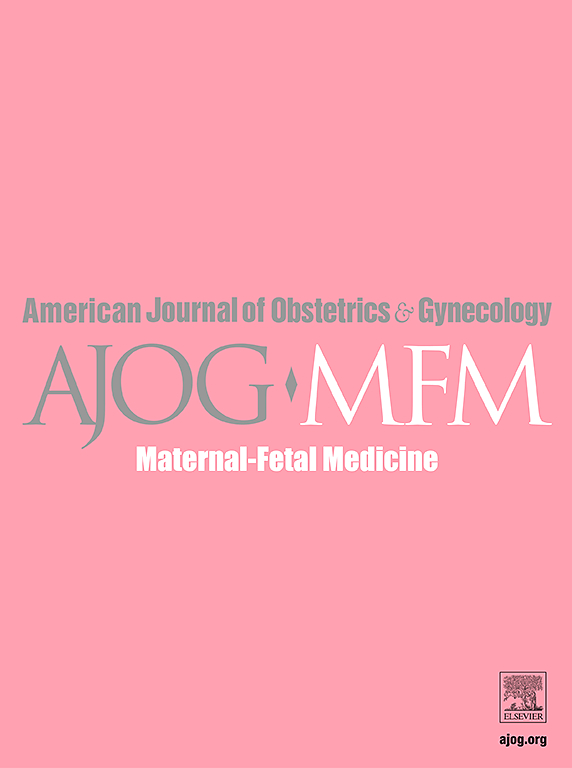Proximate cord insertion in monochorionic twins with selective fetal growth restriction
IF 3.8
2区 医学
Q1 OBSTETRICS & GYNECOLOGY
American Journal of Obstetrics & Gynecology Mfm
Pub Date : 2025-02-01
DOI:10.1016/j.ajogmf.2024.101598
引用次数: 0
Abstract
Background
Monochorionic (MC) twins share a single placenta which can be unequally shared, leading to selective fetal growth restriction (sFGR). Limited data is available on the prevalence and clinical consequences of proximate cord insertion (PCI) in sFGR pregnancies.
Objective
We aimed to investigate the prevalence of PCI in MC placentas with and without sFGR and per type of sFGR, and study the placental characteristics and perinatal outcome of PCI in sFGR pregnancies.
Study design
In this multicenter retrospective cohort study, we included all consecutive placentas of MC twin pregnancies with and without sFGR evaluated between 2002-2023. We excluded MC twins with twin-twin transfusion syndrome, twin anemia polycythemia sequence and monoamnionicity. Our primary outcome included the prevalence of PCI (distance between cord insertions ≤4 cm) and type of cord insertions categorized as concordant, intermediate or discordant. Secondary outcomes consisted of type and size of placental vascular anastomoses and short-term clinical outcomes including fetal demise and birth weight discordance (BWD).
Results
Of 813 MC placentas, 468 were from uncomplicated twins and 345 from sFGR twins (187 type I, 41 type II and 117 type III sFGR). The prevalence of PCI in uncomplicated versus sFGR placentas was 3.8% (18/468) and 4.6% (16/345), respectively (p=0.58). PCI in sFGR type I, II and III was detected in 0.5% (1/187), 0% (0/41) and 12.8% (15/117), respectively (p<0.0001). The prevalence of discordant cord insertions (velamentous-paracentral) in uncomplicated twin placentas and sFGR placentas was 19.9% (93/468) and 45.5% (157/345), respectively (p<0.0001). Diameter of arterio-arterial (AA) anastomoses in sFGR placentas with and without PCI was 3.0 mm (IQR 2.7-5.0) versus 2.2 mm (IQR 1.4-3.1; p<0.0061). BWD in sFGR twins with PCI was 18.5% (IQR 16.4-21.0) and without PCI was 28.0% (IQR 21.8-35.9; p<0.0001). Fetal demise occurred in 12.5% (2/16) of pregnancies with PCI and 6.1% (20/329) of sFGR pregnancies without PCI (p=0.27).
Conclusion
sFGR type III placentas exhibit a high prevalence of PCI, requiring increased awareness due to the presence of larger AA anastomoses and a potentially higher risk of fetal demise.
选择性胎儿生长受限单绒毛膜双胞胎的近端脐带插入。
背景:单绒毛膜(MC)双胞胎共用一个胎盘,可能不平等地共享,导致选择性胎儿生长受限(sFGR)。关于sFGR妊娠中近端脐带插入(PCI)的患病率和临床后果的数据有限。目的:探讨合并、不合并sFGR及不同类型sFGR的MC胎盘PCI的流行情况,探讨sFGR妊娠PCI的胎盘特征及围产儿结局。研究设计:在这项多中心回顾性队列研究中,我们纳入了2002-2023年间所有伴有和不伴有sFGR的MC双胎妊娠的连续胎盘。我们排除了有双胎输血综合征、双胎贫血、红细胞增多症序列和单羊膜性的MC双胞胎。我们的主要结局包括PCI(脐带插入之间的距离≤4 cm)的患病率和脐带插入类型分为和谐型、中等型和不和谐型。次要结局包括胎盘血管吻合口的类型和大小,短期临床结局包括胎儿死亡和出生体重不一致(BWD)。结果:813例MC胎盘中,无并发症双胞胎468例,sFGR双胞胎345例(I型187例,II型41例,III型117例)。无并发症和sFGR胎盘的PCI患病率分别为3.8%(18/468)和4.6% (16/345)(p=0.58)。sFGR I型、II型和III型胎盘PCI检出率分别为0.5%(1/187)、0%(0/41)和12.8%(15/117)。结论:sFGR III型胎盘PCI检出率高,由于存在较大的AA吻合口,胎儿死亡风险较高,需要提高意识。
本文章由计算机程序翻译,如有差异,请以英文原文为准。
求助全文
约1分钟内获得全文
求助全文
来源期刊

American Journal of Obstetrics & Gynecology Mfm
Medicine-Medicine (all)
CiteScore
7.40
自引率
3.20%
发文量
254
审稿时长
40 days
期刊介绍:
The American Journal of Obstetrics and Gynecology (AJOG) is a highly esteemed publication with two companion titles. One of these is the American Journal of Obstetrics and Gynecology Maternal-Fetal Medicine (AJOG MFM), which is dedicated to the latest research in the field of maternal-fetal medicine, specifically concerning high-risk pregnancies. The journal encompasses a wide range of topics, including:
Maternal Complications: It addresses significant studies that have the potential to change clinical practice regarding complications faced by pregnant women.
Fetal Complications: The journal covers prenatal diagnosis, ultrasound, and genetic issues related to the fetus, providing insights into the management and care of fetal health.
Prenatal Care: It discusses the best practices in prenatal care to ensure the health and well-being of both the mother and the unborn child.
Intrapartum Care: It provides guidance on the care provided during the childbirth process, which is critical for the safety of both mother and baby.
Postpartum Issues: The journal also tackles issues that arise after childbirth, focusing on the postpartum period and its implications for maternal health. AJOG MFM serves as a reliable forum for peer-reviewed research, with a preference for randomized trials and meta-analyses. The goal is to equip researchers and clinicians with the most current information and evidence-based strategies to effectively manage high-risk pregnancies and to provide the best possible care for mothers and their unborn children.
 求助内容:
求助内容: 应助结果提醒方式:
应助结果提醒方式:


